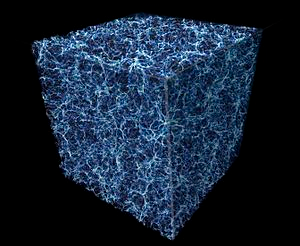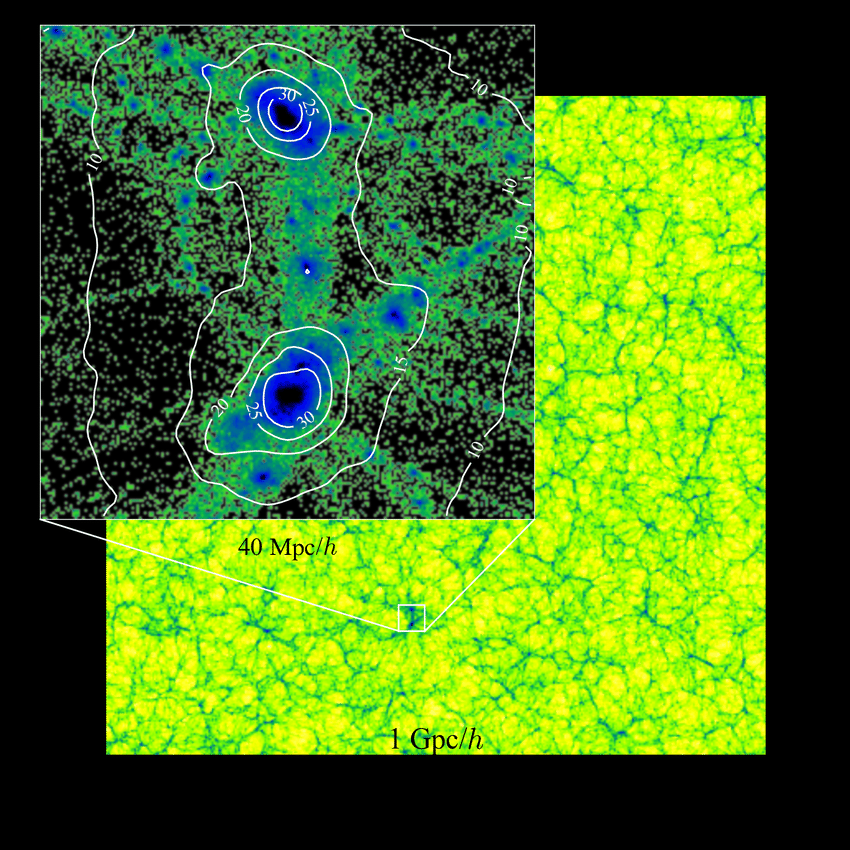Physics page

Dark Energy
Bloating - inflation. Evidence for the Big Bang?
It is desperate: In order not to refute the general theory of relativity, physics had to invent dark energy after dark matter. The observation results were also clear here. After all, the inflationary enlargements of empty bubbles in the cosmos must have a cause. In physics we don't really know any opponent of gravity (attraction). There is nothing to be seen in the bubbles - they are empty. But ´Nothing´ cannot have a flatulence effect. So there had to be something ´in´ in the bubbles that we don't see, but that drifts the space apart like yeast dough. Physicists say: we have no explanation for it. We don't know the reason! Nevertheless, we have to assume that the inflation of the space between the galaxy strands is generated by dark energy that is invisible to us. It just puffs up. Point. Check out the Wikis for more information.
The term ´Dark Energy´ does not stand for a substance, but only for an effect. For something that existed in some literature but not yet in physics: antigravity, repulsion out of nothing. We know gravity, the attraction between heavy masses that we know from everyday life. Out of a heavy mass it acts on other heavy masses. But a repulsion of heavy masses from one another, we don't know that in our everyday life.
Preview
An effect without a material cause is inconceivable for us - and that actually bothers physicists. In order to get an idea anyway, we try again the interaction principle described here. Thereafter, space and matter form an inseparable unit. Heavy matter, that is, stable and resonantly oscillating wave packets in a space filled with objects carrying momentum. By the way, quantum mechanics sees it almost exactly the same way. However, the material object is not only called wave packet or resonance, but often a harmonic oscillator. The cohesion of the material objects of the QM is based on object-internal forces. With the help of standardization procedures, QM can calculate correctly without considering the interaction of the outside / world background with the object.
The space of quantum
mechanics (the quantum vacuum) always has a positive energy content.
Out of this quantum vacuum, new matter emerges incessantly, but it
dissolves again almost immediately - like foam combs in the ocean.
See for example here.
The properties of the quantum vacuum are accordingly changed in a certain way by the interaction of the vacuum energy with the heavy matter located in it, while the total energy per volume of space basically remains the same. The deeper one dives into an accumulation of matter like a galaxy, the more often this interaction has taken place, the further the changes have progressed in the quantum vacuum.
Now the gravitational effect of mass in our representation is the result of the very weak interaction (10 exp-120 momentum -> angular momentum) of the vacuum energy of the world background with the heavy matter in it. The heavy matter affects the space by changing the impulses emanating from it in such a way that they have less ´repressive´ effect on other heavy matter, which then expresses itself in the attractive effect on other heavy matter and also effects the light waves passing the space.
The equilibrium process and its limits
QM lets heavy matter arise incessantly out of the quantum vacuum and then disappear again in it. It is obvious to see this arising and passing away as an equilibrium process that is stable under certain environmental conditions. At the edges of the spectrum of possible conditions the equilibrium process becomes unstable however, this is finally the characteristic of equilibrium processes - they can ´tilt´.
A first edge of the stability conditions (1) consists in a quantum vacuum, in which the angular momentum of the background objects dominant over its momentum. This would correspond to the state inside the accumulation of matter. The instability of the equilibrium process is then shown by the fact that more matter arises from the quantum vacuum than immediately decays. Since we adhere to the conservation of energy, the momentum current emanating from the place of origin into the environment must be weaker by the amount of energy that has condensed into the newly formed and not immediately disintegrating matter. (See above).
If we assume a
one-dimensional relationship, the other edge of the stability
conditions (2) will exist in a quantum vacuum in which the momentum
of the ITO is dominant over the angular momentum.
The equilibrium
process would ´tilt´ in another direction now. So no new matter
will arise here, but the opposite is to be expected and the matter in
this space becomes unstable and threatens to disintegrate. The
fermions and bosons will then disappear from our perception. The
measurable energy previously contained in them goes into the vacuum
energy. This will increase the impulse current going from the decay
site into the environment.
The question is now
obvious:
Are there any
indications or observations that suggest the favorable environmental
conditions (1) or (2) for attraction / repulsion?
Yes, I think so.
Picture: Distribution of dark matter
1. The ´inexplicable´ attraction has been observed in the areas of the cosmos, in which there is a very large gravitational potential and a large gradient of this potential. (dark blue in the picture above). These conditions seem to make it possible for the process to tilt in such a way that vacuum energy creates (condenses) what we call matter: fermions, bosons.
2. The inexplicable
repulsion, on the other hand, has been observed in the regions of the
cosmos where there is a great void - the voids. structure mainly DM
inbetween
voids.

These regions are characterized by exactly the opposite of 1., because there is an extremely low gravitational potential and there is no gradient between neighboring spatial points. Here the matter becomes uncomfortable and it disintegrates - mainly into impulse or vacuum energy. As a result, impulse pressure arises from the voids, apparently from within and out of nowhere, which inflates this void. This is exactly what has been observed: inflation-> repulsion in all directions.
By the way, QM also says that the Position of wave packages in the vicinity of electromagnetic fields can be predicted fairly precisely. The matter waves are obviously kept ´small and compact´ by the presence of an electromagnetically lively environment with gradient. In contrast, the prognosis for the location of matter waves after long passages in a vacuum and in the absence of fields, the more inaccurate the further the objects are from other matter. Matter waves run apparently ´diverging´ in the void, because the prognosis possibilities for the expected place are statistically distributed over more and more spaces, the longer the matter waves travel undisturbed in an environment without gradient.
